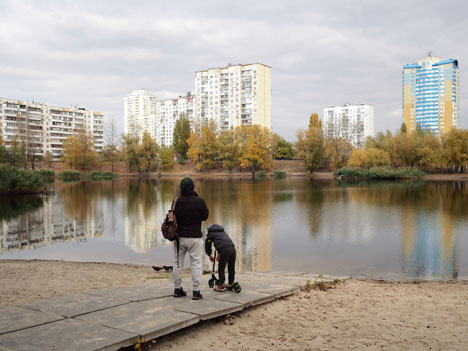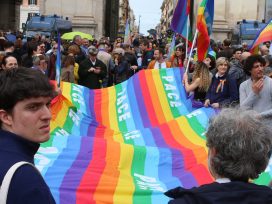In Kyiv, stylist Sasha Kanevski has made young people hanging round apartment blocks his chief source of inspiration. Kanevski is a slim man with long hair and a moustache, alert-seeming and well connected. He’s opened his studio in a private house, about twelve stops away from Kyiv’s centre by bus or underground. There are 15 people working here. Everything is done here – from the designs to the finishing touches. “It’s cheaper to make here than in China”, he explains.
With his studious demeanour, this man is a fashion name on Ukraine’s high street. Fashion for men, that is. Quite the daring venture in this country, he freely admits. He aims for a local flavour, a hard-core concrete vibe. Far away from the flashbulbs, from Maidan and its cobbled streets, he takes his inspiration from the concrete-covered side of the city.

Photo: Adeline Marquis
“I’m 33. I was born here. It’s my neighbourhood. I’m a local. This city, Kyiv is my inspiration – its local atmosphere and local subcultures”. Sasha Kanevski is a citizen who’s proud of his capital city, all the way to the end of the underground lines. The commuter suburbs, the big apartment blocks, the endless sequences of grey and the almost-white sand that’s the legacy of the draining of the marshy areas – a process that has subsequently seen apartment blocks shoot up and with them a generation of slightly sallow, frail apartment-block kids who have now grown up. “I feel close to the atmosphere of those blocks. There’s a power and a youthfulness about them that we don’t totally understand. And when you have this feeling that something doesn’t quite play by the rules, isn’t quite the way it should be, that becomes interesting”.
“Poor but sexy” – a default slogan
The post-Soviet aspect is particularly fascinating, viewed from this side of Europe. Eighties fashion, raves, that sense of transgression. A taste for all things Ost which still hasn’t become passé – as if, after Berlin, Europe has found its new city en vogue, between vodka and techno. The setting seems right, and the energy is there too.
This fashion designer is no different. When he isn’t off taking photos at the bottom of the tower blocks, he brings the tower blocks to the catwalk. For his latest show, he’s chosen local youngsters. “We went for an agency based on the ‘Lumpen’ agency in Moscow, which shows a different side to beauty – kids from the blocks, skaters, people who aren’t that beautiful in the conventional sense, they’re not tall or muscular – but I like that kind of beauty”. An everyday staging, in some ways, but also a spotlight on precisely those people to whom Ukraine has paid little attention until now.
“The mayor of Berlin described his city as ‘poor but sexy’, and you can say the same thing about Kyiv”, he says. But he does so without a trace of triumphalism or romanticism. From a European perspective, viewed from Germany, France or Britain, there is indeed something sexy about the post-Soviet world, he admits. “But here, it’s completely different. No one makes a big thing about it. We have no other choice”. “Poor but sexy” might seem a nice slogan, but here it exists by default.
The “superblock” – a city like any other
What’s more, Kanevski is replacing the fad for these eastern “superblocks” with a global trend that isn’t explicitly post-Soviet in nature. “This is all part of a global trend – brutalism”. And this is its local offshoot, postsovok (post-Soviet). “This doesn’t surprise anyone any more. And these neighbourhoods exist all over the world. They’re very close in terms of the way they feel”.
Exoticism is out. The towers of these “superblocks” in Kyiv are built on beaten sand just as others are built on concrete slabs. Here too, young people go out in tracksuits and conversations often turn to “pimping one’s ride”. People defend their territory. The metro is either full or empty when it stops there. People don’t go out in the commuter areas of Troieschyna or Obolon. They go back home there to sleep. These days they can even meet their neighbours online, not needing the friendships that were once forged in stairwells.
This is a population that Kanevski finds it hard to reach, notwithstanding Übernormal, his brand of cheap hoodies and jeans. According to him, it is difficult to get young people from these tower blocks out of their everyday existence, difficult to get them interested in the fashion that has them as its subject. “They’re not interested. To be noticed in the towers, you’ve got to be on TV. Everyone watches TV over there. It’s the only way”.
Far from showing us the craze of young urbanites in downtown Kyiv for this new Eldorado of the east, the designer points up a geographical, cultural and social divide that is more than a little reminiscent of other large European cities, and that invites us to view Kyiv first and foremost as an ordinary city.








